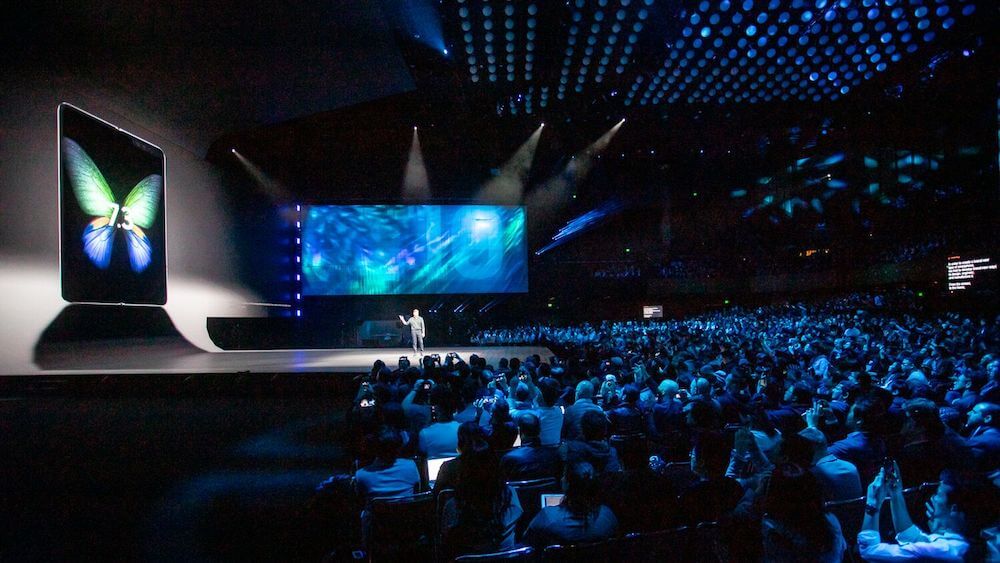
The stage at the 10th annual Galaxy Unpacked, a live experience that Agency AE partnered with Samsung that showcased Samsung’s new product launches.
Based on an industry-wide research study, Agency EA’s “2019 Experiential Marketing Trends Report” uncovered a number of emerging trends and traditional tactics that are being approached in new ways. The top 10 trends include:
1. Location integration. It’s becoming increasingly popular to integrate local talent, cuisine, and characteristics into your B2B events. Doing so makes the event feel more original and unique, while supporting the local destination community. And attendees love it: Eighty-two percent of potential attendees say their decision to attend an event is influenced by its location, according to Agency EA’s “2019 State of Experiential Research Study.”
2. Keen to be green. As increasing numbers of consumers expect brands to be more environmentally conscious, event producers are working to make their events greener. Plastic-free events are increasingly common, as are efforts to create menus with less meat and to use recycled materials whenever possible. There’s also a growing push to make events more walkable, eliminating the need for shuttles and other ground transportation.
3. All attendees welcome. Producers are working to make their events welcoming for broader audiences, offering diverse amenities such as family rooms with child care, pet care, meditation and prayer rooms, gender-neutral bathrooms, and menus that address a variety of dietary restrictions. When events appear to welcome all attendees, more attendees are likely to participate and have a positive experience.
4. It’s not personal, it’s hyper-personal. Advanced technologies make it easier to personalize each attendee’s experience, and more events are taking advantage of that opportunity. Some of the ways events are personalizing experiences include acknowledging returning attendees, scheduling orientations for new attendees, and providing session or content suggestions based on attendee data gathered through registration or wearable devices.
5. Big data, big results. Event producers are analyzing the data collected from their events to improve the next version, and they’re also analyzing data collected from individual attendees. Using heat maps, traffic patterns, and attendee wearables, event organizers can break down how various sessions, networking events, or other components influence attendee behavior.
6. Quality over quantity. Just as Samsung hosts only two large events each year, other event producers are increasingly choosing to hold fewer events for more intentional experiences. Rather than holding events because they’ve always been done, more event professionals are digging into the why behind each event and making sure they can deliver focused experiences that lead to success.
7. Take the work out of networking. More event organizers are looking for ways to make networking opportunities less stressful and more enjoyable, productive experiences. For many, that involves creating environments and activities that facilitate organic attendee connections and make it easier for participants to develop natural conversation and collaboration.
8. Stages that shine. In-person events are valuable, but they can attract much wider audiences if they also provide rich experiences for virtual attendees who access the event through livestreaming or on-demand video after the live event concludes. More events are keeping the online audience in mind as they design stages and keynote addresses to provide them with a positive experience that mimics that of the live audience.
9. Forge your own (event format) path. Event organizers continue to look for new ways to move their events out of traditional conference venues and agendas and design new formats that keep audiences engaged. Some events are doing this by incorporating play into conferences to hold attendees’ attention and help them remember more from the event.
10. Inspiring influencers and smart sponsorships. More B2B events are adopting the B2C approach of partnering with brands or personalities that complement their mission and share their values. With social-media influencers as well as traditional corporate sponsors, the possibilities are endless.
Read More
- Learn about how Agency EA partnered with Samsung to leverage experiential marketing at the brand’s 10th annual Galaxy Unpacked event.
- Receive one clock hour of certification credit by reading the articles from our July Convene CMP Series.
